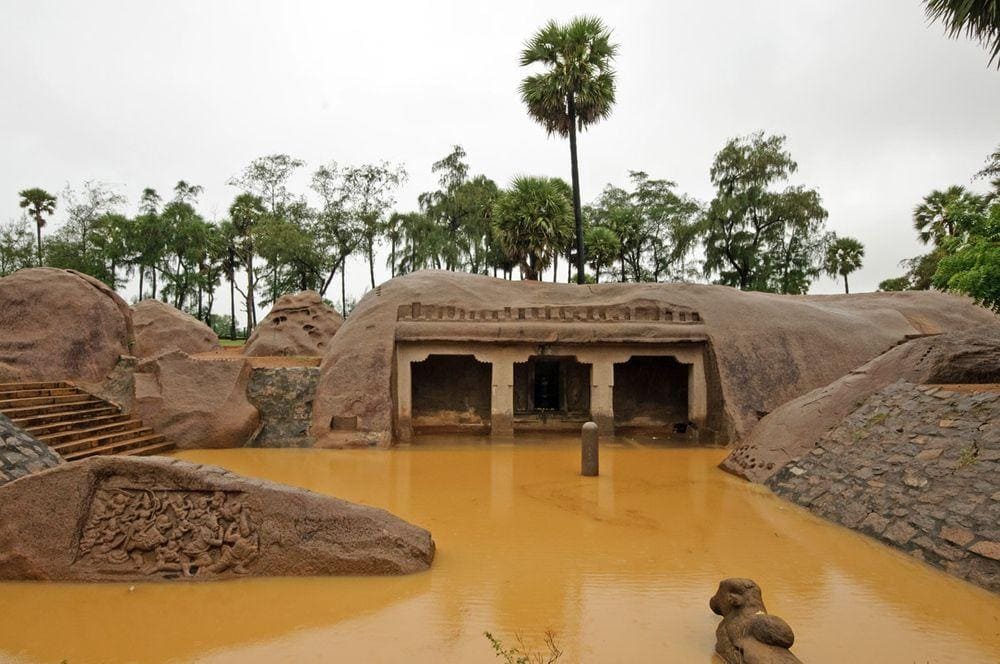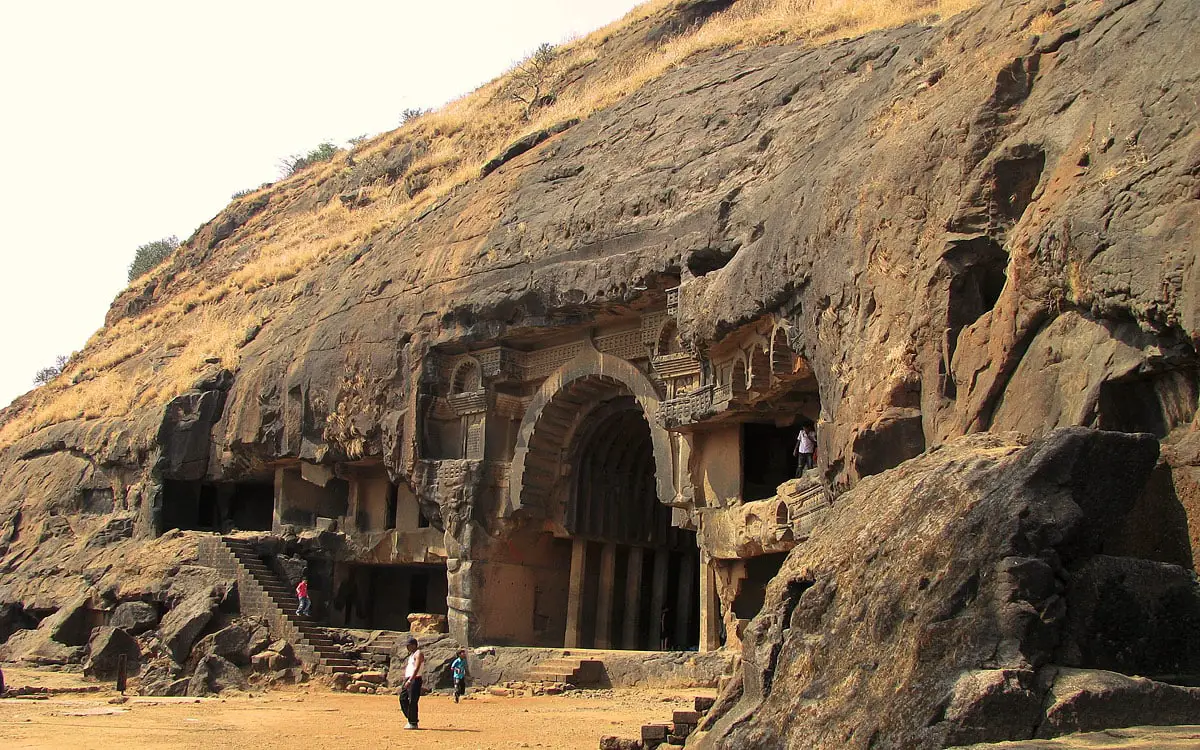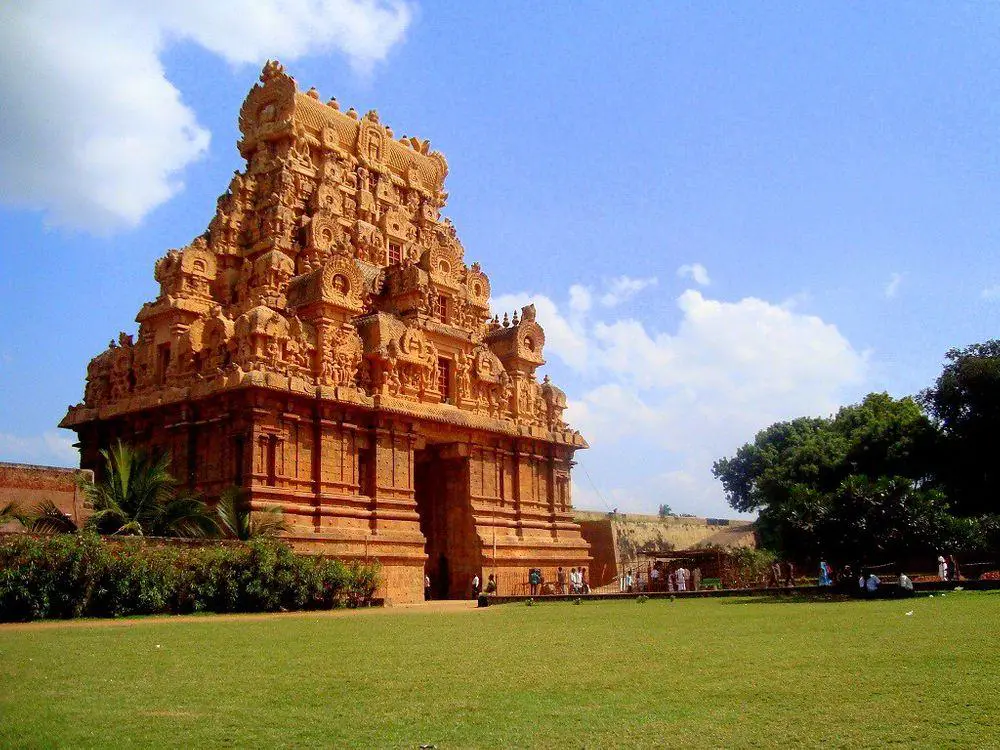World 🢖 Asia 🢖 India 🢖 Tamil Nadu
Hindu shrines 🢔 Religious architecture 🢔 Architectural wonders 🢔 Categories of wonders
Wonder
Atiranachanda Mandapam

 In short
In short
Although the somewhat peripheral Atiranachanda Mandapam is overshadowed by many other famous stone cut temples of Mahabalipuram, it has several qualities making this rock-cut Hindu temple unique.
 39.8%
39.8%
GPS coordinates
Location, address
Alternate names
Age
Religion
Map of the site
If you see this after your page is loaded completely, leafletJS files are missing.
 In detail
In detail
The unique monuments of Mahabalipuram were carved in diorite approximately 1200 – 1300 years ago, in the times of the Pallava dynasty. Diorite is one of the hardest rocks – but ancient artisans shaped it with great proficiency.
Mistakes were not allowed: work was done in a live rock that in a case of unexpected notch could not be replaced with another block. They mastered many techniques, some are well known up to this day but some for sure are long forgotten. This was hard, loud, dusty, and sophisticated work – but we may rest assured that these temples will survive for many thousands of years to come.
Three parts
The Atiranachanda Mandapam is rectangular in plan, with comparatively simple planning. It consists of three parts – forecourt (maha mandapam), verandah (artha mandapam) and a smaller garbagriha – sanctum sanctorum.
Forecourt contains sculptures of nandi and elongated lingam. One side of the forecourt contains interesting artwork – the Mahishasuramardini panel (see description below). Lingam under the open sky is an unusual and unexplained feature.
Verandah is divided from the forecourt with two columns and two pilasters. In front of the verandah, there are two identical inscriptions in different writings – one in Pallava Grantha and another – in Devanagari (the oldest known Devanagari inscription in the Indian subcontinent). Calligraphy of inscriptions is delightful. They refer to the temple as Atiranachanda-ishvara griha – some unknown Atiranachanda Pallava devoting this temple to Siva, Uma, and Skanda. The name “Atiranachanda Pallava” was attributed both to Paramesvara I and his son Rajasimha. On the floor there is another inscription from Chola (Rajaraja I) times – it records the gift of 90 goats for a perpetual lamp in the temple – in this inscription the town is mentioned as Tiruvizhichchal.
Entrance in garbagriha is symbolically guarded by two dvarapalas with clubs in hands. This small cell houses Shiva-lingam. This sacred symbol os of rare form – this is dhara-linga. Dhara-linga is made of black, polished stone with angular sides and is characterized by the impressive play of light. Lingam in Atiranachanda Mandapam has 16 edges.
Wall behind the lingam is adorned with sculpted relief which shows Shiva as Somaskanda, with his consort Uma and child Skanda. This sculptural group was typical in the art of Pallavas. On both sides of the family stand Brahma and Vishnu. Depiction of Brahma is especially interesting – he is shown with three faces (Trimurti).
There are two more very similar sculptural groups of the same content in the temple, which is an unusual detail. Earlier image from the late 19th century shows that in front of each panel there was a standing lingam made of dark stone, nowadays only the central lingam in garbagriha remains. It is considered that all three lingams were added in later times.
Most likely this cave temple was made over a longer period of time, where during the reign of each Pallava were added details characteristic for each time.
Mahishasuramardini panel
This panel is approximately 1.8 m wide and 0.9 m high and shows Goddess Durga sitting on the lion and slaying the demon-king Mahishasura. This is smaller than the similar and more famous panel in Mahishasura Mardini Cave.
Defeat of demon is symbolized by the lack of umbrella over him and jubilant ganas around Durga. Durga herself has been depicted with success as a beautiful woman with a pearl necklace and other adornments. Goddess has six hands.
Demon Mahishasura looks tired and defeated, with an open mouth and wide nostrils. An unusual feature of this group is also a human-like figure running away.
Subrahmanya Temple
The terrible tsunami in late 2004 led to the discovery of an exciting monument – there was washed brick wall of a hitherto unknown collapsed monument near Atiranachanda Mandapam. Already earlier there was found an inscription from times of Kulottunga III telling about a temple for Subrahmanya. Further excavations led to the discovery of inscriptions on two granite pillars and thus it was identified as the mentioned Subrahmanya Temple.
Just 150 – 200 m south from Atiranachanda Mandapam there is located another amazing monument of ancient art – Yali Mandapam or Tiger Cave.
References
- Worship of Lord Brahma, Part 71, Harekrsna.com. Accessed on April 14, 2010.
- Mahabalipuram, Trip to Mahabalipuram on December 5, 2007. Indian Heritage. Accessed on April 14, 2010.
- The Saluvakkuppam Complex, Tamil Heritage. Accessed on April 18, 2010. Contains the text of inscriptions!
 Linked articles
Linked articles

Rock-cut architecture and sculptures
Rock-cut architecture is a very ancient form of architecture – the oldest structures are more than 5 thousand years old. The resistivity of the natural stone and the constant climate inside these structures has preserved many art values around the world.

Hindu shrines
Hinduism is one of the oldest religions – possibly the oldest one among contemporary religions and Hindu temples belong to the most impressive religious buildings in the world.

Wonders of India
India is the seventh-largest country in the world by area, and, naturally, such a large area contains a huge amount of exciting attractions…
Wondermondo considers that India is the second richest center of architectural heritage in the world after Europe and maybe no single country in the world can match it in this respect.
 Recommended books
Recommended books
Tamil Nadu: The Heart of Dravidian India
The huge temples of Tamil Nadu are justifiably famous. Through history and forty-four original photographs, this book explains how the temples came to be and what their statuary symbolizes. The book also paints a picture of what life was like in the civilizations that built them.
Mahabalipuram (Monumental Legacy)
Built in 700 CE by the famous Pallava king Rajasimha, Mahabalipuram is a unique monument where art form combines with religion and legends. Also known as Mamallapuram, it showcases the best of Tamil art and architecture. The beauty of the monument is further enhanced by its location on the shores of the Bay of Bengal, the latter significantly influencing the creations. Part of the prestigious Monumental Legacy series, this book presents a graphic account of the site and its monuments-mandapas (cave temples), rathas (chariots), open-air bas-reliefs, and structural temples.


